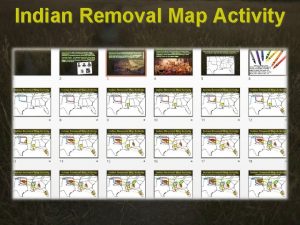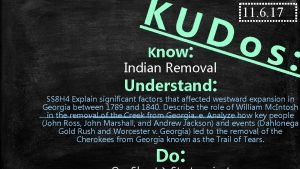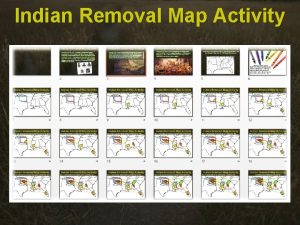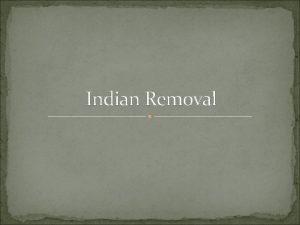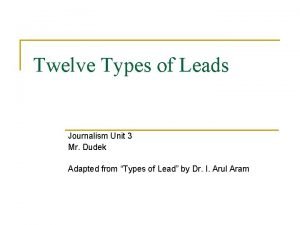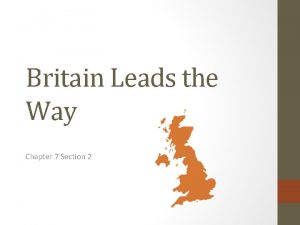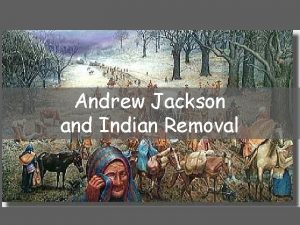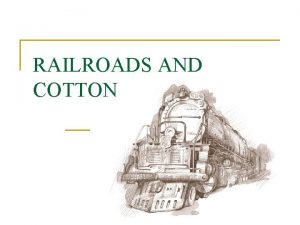Land Fever leads to Indian Removal Railroads Georgia
























- Slides: 24

Land Fever leads to Indian Removal

Railroads • Georgia chose to begin laying railroad track in the 1840’s. • Georgia became the leader in the south for railroad production. • By creating a way to deliver goods and people faster, it provided the means for growth in economy. • Many small towns grew into cities once the railroad reached them. • More than 500 miles of railroad was built by the 1850’s.

Cotton and the Cotton Gin • Eli Whitney in 1793 invented a machine for separating cotton seeds from its fiber • Increased the amount cotton growers could process each day • The gin used wire teeth on a turning cylinder to separate the seed from fiber

Railroads and Cotton Gin • One major reason for Georgia’s rapid economic growth was the success of the cotton crop. • The cotton gin allowed for the production or more cotton, this allowed Georgia to become one of the top cotton producers in the world. • The growth of railroads allowed Georgians to plant cotton even further inland because they had a means to transport it quickly and efficiently. • The city of Atlanta has its roots in the railroads. Within 15 years, Atlanta was the center of railroad traffic in the south. – Began as Terminus (end of the rail line), 1843 became Marthasville, 1845 name was changed to Atlanta.

SALMA Capital Moves SALMA • 1785 the capital of Georgia was moved from Savannah to Augusta. • 1796 the capital was moved to Louisville. • 1806 the capital was moved again to Milledgeville • Finally, in 1868 the new state Constitution (after the Civil War) moved the capital to Atlanta • All of the moves of the state capital were made due to population shift. As the population moved westward so did the state capital.

Education in Georgia • The University of Georgia chartered in 1785 as nation’s first land-grant university; opened for classes in 1801 • Land was provided by the General Assembly • UGA was often called Franklin College in its early days • By 1820, there were forty academies (schools) across the state • Georgia Female College (later Wesleyan College) opened in 1836

Headright System • Indian land in Georgia east of the Oconee River was given to settlers • Every white male counted as a head of household and had the “right” to receive up to 1, 000 acres – 200 acres, plus 50 acres per family member including slaves---only cost was survey fee

Yazoo Land Fraud • Around 1795, four companies bribed the governor and legislators • Bought millions of acres in western Georgia (today’s Alabama and Mississippi) for 1½¢ an acre • The public found out and protested; the legislators involved were voted out of office • General Assembly repealed the law approving the sale; the federal government paid more than $4 million to help Georgia settle Yazoo land claims

Land Lottery • This replaced the headright system in 1803 to distribute government-owned land west of the Oconee • The new system to distribute lands came about as a result of the Yazoo land fraud. It was designed to give everyone an equal chance to own land. • All white males who had lived in Georgia for one year was given one chance • A man with a family, and a widow with children were given two chances. • millions of acres in several states were given away

The Western Territory • In 1802, Georgia ceded • (gave up) its land claims west of the Chattahoochee River to the federal government for $1. 25 million with the promise that the Indians would be removed from Georgia. President Thomas Jefferson doubled the nation’s size in 1803 with the Louisiana Territory Purchase; the U. S. paid France $15 million for land that stretched to the Rocky Mountains

Frontier Georgia • Undeveloped land in central and western Georgia • Few settlers; much land given away in land lotteries • Georgians desired fertile farmland to the west and came into conflict with Creeks living there

Andrew Jackson • Developed a reputation as a war hero fighting the British and Indians in the early 1800’s • Became the 7 th president in 1828 • Signed the Indian Removal Act in 1830

Creek Indians • The Muscogee (Creek) were the dominant tribe in Georgia for thousands of years

Creek Indians Settlers on the frontier feared Indian attacks Georgians desired to push the Indians out, while the Creek fought to keep their land. – The federal government had promised in the Yazoo Land settlements to help with the removal of the Creek and Cherokee Indians Land treaties were often broken Red Stick Creeks endorsed war to fight for their land claims; White Stick Creeks wanted peace

The Creek War • Red Sticks attacked Fort Mims, killing more than 400 people • The Battle of Horseshoe Bend, in Alabama, ended the Creek War in 1814; Andrew Jackson led the U. S. troops • The Creeks were forced to give up nearly all their land to the U. S. government

• Chief William Creek Mc. Intosh • Chief of lower Creek Indian tribe • Fought with Andrew Jackson against the red sticks • Worked with the state to get the Creeks to sell their land (said to have received money for this) Removal

Creek Removal Continued • The Treaty of Indian Springs gave up last Creek lands in Georgia to the U. S. • Chief William Mc. Intosh was later murdered by rival Creeks for signing the treaty • By 1827 the Creeks had relocated to the wilderness across the Mississippi River

Cherokee Culture • Most “advanced” or “civilized” of Georgia’s tribes; learned quickly from white settlers • The Cherokee nation an independent government, a capital city (New Echota), and a constitution. 20 Cherokee government buildings were located here They had their own school and library They had their own paper, The Cherokee Phoenix, which was bilingual.

Cherokee Indians Sequoyah (George Gist) developed a syllabary, a group of symbols that stand for whole syllables; it gave Cherokees a written form of their language (which was used with in the paper).

Cherokee Indians • John Ross – Chief of the Cherokee – Made several trips to Washington to ask Congress for help – Wanted the Cherokee Nation protected and the terms of past treaties honored – Took a petition to Congress with 15, 000 signatures (90% of all Cherokee) – Fought against the Indian removal – He went on the Trail of Tears and was a leader in the building of their new home in present day Oklahoma • Led the effort to build farms, schools, and businesses

Cherokee Indians • 1829 the Dahlonega Gold Rush began – Benjamin Parks is credited with the discovery even though the Indians had known of its existence. – Cherokee faced more pressure to give up and abandon their land. • The General Assembly declared Cherokee law was null and void and would not allow Cherokees to speak against a white man in court. • December 1829 another law was passed that refused the Cherokees any right to gold mined in the Dahlonega area. • The Cherokee were losing their homes, lands, and legal rights.

Cherokee Indians • Worcester v. Georgia – Landmark court case that should have protected the Cherokee Nation – General Assembly passed a law in 1830 that said white people could only live on Cherokee land if they take an oath of allegiance to the Governor of the state • • 11 refused to take the oath They were released and jailed again the same year Chained and made to walk a long way Found guilty at trial—sentenced to four years

Cherokee Indians Worcester v. Georgia Cont. • John Ross, Cherokee Chief argued the case before the Supreme Court of the United States. • John Marshall was the chief Justice of the Supreme Court of the United States. He ruled in favor of Samuel Worcester when his case made it to the court. • In 1832, Chief Justice John Marshall ruled in favor of the Cherokee • Marshall said that Georgia laws were not valid in Cherokee lands • President Andrew Jackson and the governor of the state ignored the ruling, and ordered the Indian removal. • “John Marshall has made his decision…now let him enforce it”- Andrew Jackson

The Trail of Tears • 1830 Indian Removal Act passed in U. S. Congress – Passed to move the Native Americans western territories • Between 1832 and 1835, Cherokees were stripped of their land • In the summer of 1838, almost 14, 000 Cherokees were forcibly removed to Oklahoma; it was an 800 mile journey • about 4, 000 men, women and children died from disease, exposure, or hunger • 700 to 800 escaped and hid in the North Carolina mountains
 Pathologic q wave criteria
Pathologic q wave criteria Indian removal map activity
Indian removal map activity Indian removal act of 1830
Indian removal act of 1830 Who signed the indian removal act of 1830
Who signed the indian removal act of 1830 Indian removal act of 1830
Indian removal act of 1830 Indian removal act map
Indian removal act map Shawnee land laser hair removal
Shawnee land laser hair removal Guided reading activity lesson 2 the railroads
Guided reading activity lesson 2 the railroads Chapter 14 section 2 the age of the railroads
Chapter 14 section 2 the age of the railroads Manifest destiny railroads
Manifest destiny railroads The modern colossus of railroads political cartoon meaning
The modern colossus of railroads political cartoon meaning Lesson 2 the railroads
Lesson 2 the railroads Railroads
Railroads Chapter 6 section 2 the age of the railroads
Chapter 6 section 2 the age of the railroads Railroads
Railroads An area of land largely enclosed by higher land
An area of land largely enclosed by higher land High rocky land usually with steep sides
High rocky land usually with steep sides 一路我蒙救主引领
一路我蒙救主引领 Adequate planning leads to the correct completion of work
Adequate planning leads to the correct completion of work Types of leads journalism
Types of leads journalism Types of leads
Types of leads Dira leads
Dira leads Chapter 7 section 2 britain leads the way worksheet answers
Chapter 7 section 2 britain leads the way worksheet answers Chapter 17 section 3 luther leads the reformation
Chapter 17 section 3 luther leads the reformation What is a staccato lead
What is a staccato lead

